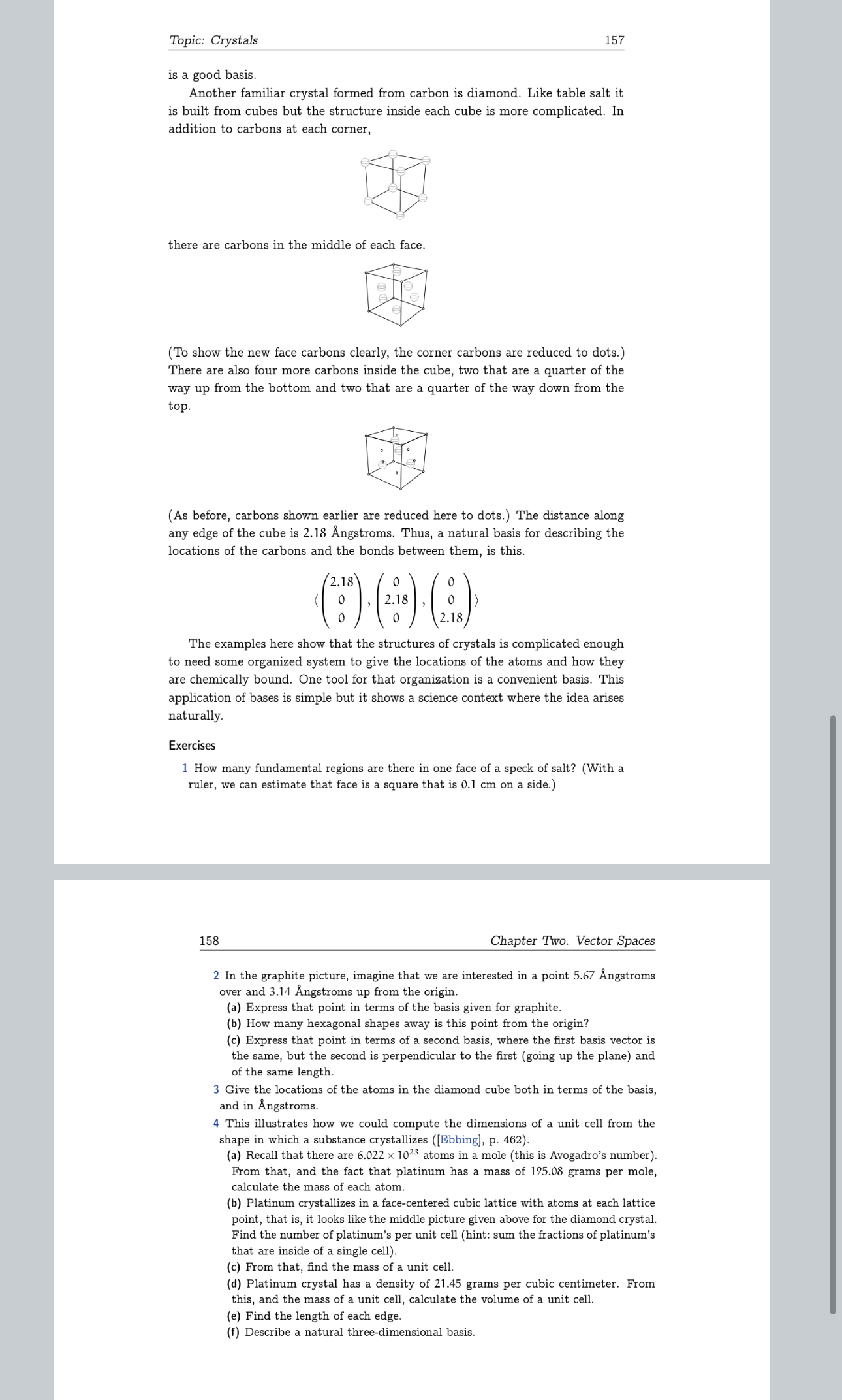Answered step by step
Verified Expert Solution
Question
1 Approved Answer
This orderly outside arises from an orderly inside - the way the atoms lie is also cubical, these cubes stack in neat rows and columns,
This orderly outside arises from an orderly inside the way the atoms lie is also cubical, these cubes stack in neat rows and columns, and the salt faces tend to be just an outer layer of cubes. One cube of atoms is shown below. Salt is sodium chloride and the small spheres shown are sodium while the big ones are chloride. To simplify the view, it only shows the sodiums and chlorides on the front, top, and right.
The specks of salt that we see above have many repetitions of this fundamental unit. A solid, such as table salt, with a regular internal structure is a crystal.
We can restrict our attention to the front face. There we have a square repeated many times giving a lattice of atoms.
Chapter Two. Vector Spaces
The distance along the sides of each square cell is about Angstroms an Angstrom is meters When we want to refer to atoms in the lattice that number is unwieldy, and so we take the square's side length as a unit. That is we naturally adopt this basis.
::
Now we can describe, say, the atom in the upper right of the lattice picture above as vecvec instead of Angstroms over and up
Another crystal from everyday experience is pencil lead. It is graphite, formed from carbon atoms arranged in this shape.
This is a single plane of graphite, called graphene. A piece of graphite consists of many of these planes, layered. The chemical bonds between the planes are much weaker than the bonds inside the planes, which explains why pencils write the graphite can be sheared so that the planes slide off and are left on the paper.
We can get a convenient unit of length by decomposing the hexagonal ring into three regions that are rotations of this unit cell.
The vectors that form the sides of that unit cell make a convenient basis. The distance along the bottom and slant is ngstroms so this
::
Topic: Crystals
is a good basis.
Another familiar crystal formed from carbon is diamond. Like table salt it is built from cubes but the structure inside each cube is more complicated. In addition to carbons at each corner,
there are carbons in the middle of each face.
To show the new face carbons clearly, the corner carbons are reduced to dots. There are also four more carbons inside the cube, two that are a quarter of the way up from the bottom and two that are a quarter of the way down from the top.
As before, carbons shown earlier are reduced here to dots. The distance along any edge of the cube is ngstroms Thus, a natural basis for describing the locations of the carbons and the bonds between them, is this.
::
The examples here show that the structures of crystals is complicated enough to need some organized system to give the locations of the atoms and how they are chemically bound. One tool for that organization is a convenient basis. This application of bases is simple but it shows a science context where the idea arises naturally.
Exercises
How many fundamental regions are there in one face of a speck of salt? With a ruler, we can estimate that face is a square that is on a side.
Chapter Two. Vector Spaces
In the graphite picture, imagine that we are interested in a point Angstroms over and Angstroms up from the origin.
a Express that point in terms of the basis given for graphite.
b How many hexagonal shapes away is this point from the origin?
c Express that point in terms of a second basis, where the first basis vector is the same, but the second is perpendicular to the first going up the plane and of the same length.
Give the locations of the atoms in the diamond cube both in terms of the basis, and in ngstroms
This illustrates how we could compute the dimensions of a unit cell from the shape in which a substance crystallizes Ebbing p
a Recall that there are atoms in a mole this is Avogadro's number From that, and the fact that platinum has a mass of grams per mole, calculate the mass of each atom.
b Platinum crystallizes in a facecentered cubic lattice with atoms at each lattice point, that is it looks like the middle picture given above for the diamond crystal. Find the number of platinum's per unit cell hint: sum the fractions of platinum's that are inside of a single cell
c From that, find the mass of a unit cell.
d Platinum crystal has a density of grams per cubic centimeter. From this, and the mass of a unit cell, calculate the volume of a unit cell.
e Find the length of each edge.
f Describe a natural threedimensional basis.

Step by Step Solution
There are 3 Steps involved in it
Step: 1

Get Instant Access to Expert-Tailored Solutions
See step-by-step solutions with expert insights and AI powered tools for academic success
Step: 2

Step: 3

Ace Your Homework with AI
Get the answers you need in no time with our AI-driven, step-by-step assistance
Get Started


